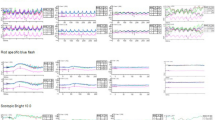Summary
Oligocone trichromasy is a rare form of congenital incomplete monochromatism.
Patients and methods: An 11-year-old girl presented because of reduced visual acuity while color vision was almost normal. Besides a general ophthalmological examination, special psychophysical tests, such as perimetry, color vision tests using pseudoisochromatic plates, arrangement tests, the Nagel anomaloscope and spectral sensitivity measurement, and electrophysiological tests (electroretinogram and electrooculogram) were conducted.
Results: The tests yielded the following: congenital nystagm, normal results at ophthalmoscopy, best visual acuity of 0.1 monocular and 0.2 binocular. Perimetry revealed a relatively central scotoma. All color vision tests showed only mild dysfunction of the blue-sensitive cones. Findings at photopic electroretinogram were almost completely lacking. There was no sign of progression in the last 6 years.
Conclusion: Differential diagnosis includes all diseases associated with congenital nystagm, such as aniridia, diseases of the optic nerve, albinism and all forms of hereditary cone dysfunction, cone dystrophies and complete and incomplete congenital stationary monochromatism. In the present case the findings are most congruent with oligocone trichromasy.
Zusammenfassung
Die „Oligocone“-Trichromasie (OCT) ist eine seltene Form der angeborenen inkompletten Achromatopsie. Eine Fallbeschreibung soll dieses Krankheitsbild erläutern:
Patient und Methode: Ein 11-jähriges Mädchen fiel durch ein reduziertes Sehvermögen bei fast normalem Farbunterscheidungsvermögen auf. Neben allgemeinophthalmologischen Untersuchungen wurden spezielle psychophysische Untersuchungen (Gesichtsfeld, Pseudoisochromatische Tafeln, Farbanordnungstests, Anomaloskop und Analyse der spektralen Empfindlichkeit) sowie elektrophysiologische Untersuchungen angewendet.
Ergebnisse: Die folgenden Befunde konnten bei kongenitalem Nystagmus und unauffälligem Fundusbefund erhoben werden: monokularer Visus bei bestmöglicher Korrektur beidseits 0,1; binokular 0,2; im Gesichtsfeld eine relatives Zentralskotom, in allen Farbsinnprüfungen geringe Störungen im Blaubereich, im photopischen ERG lediglich Restantworten. Diese Befunde waren in den letzten 6 Jahren stationär.
Schlußfolgerung: Die Diagnose einer Sonderform der inkompletten Achromatopsie, der „Oligocone“-Trichromasie nach van Lith (1972) wurde gestellt. Differentialdiagnostisch sollten alle Krankheiten in Betracht gezogen werden, die mit einem kongenitalen Nystagmus einhergehen, z. B. Optikuserkrankungen, Albinismus oculi, hereditäre Zapfendysfunktionen und Zapfendystrophien sowie die kompletten und inkompletten Formen der angeborenen stationären Achromatopsie.
Similar content being viewed by others
Author information
Authors and Affiliations
Rights and permissions
About this article
Cite this article
Ehlich, P., Sadowski, B. & Zrenner, E. Oligocone trichromasy – a rare form of incomplete monochromatism. Ophthalmologe 94, 801–806 (1997). https://doi.org/10.1007/s003470050207
Issue Date:
DOI: https://doi.org/10.1007/s003470050207



